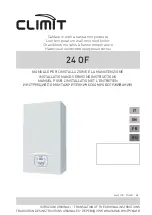
TECHNICAL ASSISTANCE CENTRE
15
18 MAINTENANCE
Scheduled maintenance is essential for the safety, efficien-
cy and long working life of your storage cylinder. Proper
maintenance also reduces energy consumption and en-
sures reliability over time. Have your storage cylinder ser-
viced either by the manufacturer’s Technical Assistance
Centre or by a qualified heating engineer at least once a
year.
Perform the following operations before beginning any
maintenance:
- Switch the electricity supply to the storage cylinder’s
valve group and to any associated boiler OFF at the
main switch and at the control panel
- Close the shut-off cocks for the domestic hot water
circuit
- Drain the storage cylinder’s DHW (secondary) water
circuit.
19 CLEANING AND REMOVING
INTERNAL COMPONENTS
EXTERNAL CLEANING
Clean the outside of the storage cylinder with a soft cloth
damped in soapy water. To remove stubborn marks, use a
cloth damped in a 50% mix of water and denatured alco-
hol or a suitable cleaning product. Dry the storage cylinder
after cleaning it.
a
Do not use abrasive products, petrol or triethylene.
INTERNAL CLEANING
Removing and checking the magnesium anode
- Remove the cap (1), cover (2) and the anode insula-
tor disc.
1
2
- Use a 45 mm wrench to unscrew the anode plug (3).
3
- Check the magnesium anode for wear and replace it
if necessary.
- Repeat this operation on the second magnesium an-
ode, using a suitable box spanner to remove it.
- On completion of cleaning, follow the above steps in
the reverse order to refit all removed parts.
NOTE: Tighten the anode plug to a torque of 25-30 Nm.
Cleaning inside the storage cylinder
- Remove the flange cover (4)
- Unscrew the bolts (6) securing the flange (5) and re-
move the flange
- Remove the seal
- Clean inside the storage cylinder and remove any
residues through the access hole.
4
5
6
b
Check the seal for wear and replace it if necessary.
On completion of cleaning, follow the above steps in the
reverse order to refit all removed parts.
b
Tighten the bolts (6), proceeding diagonally around
the flange to apply pressure uniformly around the
seal.
- Fill the storage cylinder’s DHW (secondary circuit)
and check that there are no leaks from any of the
seals
- Check the performance of the storage cylinder.






































